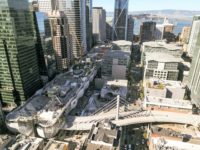California high-speed rail: Everything you need to know

The $64 billion plan to bring 800 miles of track up and down the Golden State

You’ve probably heard that California is trying to build its own shiny and speedy bullet train. After voters approved a 2008 ballot proposition that kicked off one of the nation’s largest and most ambitious infrastructure projects, the state’s High Speed Rail Authority has been hard at work attempting to will the conflict-ridden yet positively utopian train into existence.
If construction plays out on schedule (and funds don’t dry up), the train’s first phase should be complete by 2029. Threading the state together from San Francisco down to Orange County, Phase 1 of the California High Speed Rail (HSR) project promises a cheap two-hour-and-40-minute ride between San Francisco’s Transbay Terminal and LA’s Union Station.
However, as you might have heard, the train is in trouble. As it copes with a persistent volley of antagonistic litigation, a high cost of $64 billion, and even political challenges enabled by the Trump administration, the bullet train’s boosters and builders have a challenge before them.
Despite the controversy, construction activity for HSR is well under way in many parts of the state. Passenger service between San Jose and Bakersfield is expected as soon as 2025. And cities all across California are incorporating the train into their own long-term regional transportation plans.
Tracking a project of this magnitude is, of course, a bit of a challenge, which is why we’ve put together this handy explainer:
What exactly is California trying to build?
As outlined in the “Safe, Reliable High-Speed Passenger Train Bond Act for the 21st Century,” which California voters passed 53 percent to 47 percent in 2008, the HSR project will build approximately 800 miles of track up and down the state, connecting together most of the state’s large cities with up to 24 different stations. With an anticipated cruising speed of 220 mph, the train is intended to provide Californians with a fast and convenient option to travel throughout the Golden State without relying on their cars or short-haul airplane flights.
The project is supposed to open in legs. The first, connecting San Jose to the Central Valley, is scheduled to begin passenger service in 2025. Stops along this leg will include San Jose, Gilroy, Merced, Madera, Fresno, Tulare County, and Bakersfield.
The second leg, expected to open in 2029, will build out tracks from San Jose to San Francisco’s Transbay Terminal, including a Peninsula stop in Millbrae; and south from Bakersfield to Anaheim, with stops in Palmdale, Downtown Los Angeles, and at Burbank Airport.

The proposed timeline on the later extensions of the project are foggier, but the state plans to add a 110-mile Sacramento extension, connecting to Modesto and Stockton on its way, and a 167-mile segment that snakes east from Los Angeles through the San Gabriel Valley to the Inland Empire, and eventually down south to San Diego.
Altogether, the train’s proponents envision the HSR as a much-needed boost to the state’s aging and overcapacity infrastructure. Though the state’s population continues to grow, our freeways and our airports cannot. And, aside from creating an alternative for long-distance travel, HSR will also provide funds for cities to better develop their own local transportation systems and integrate the HSR station into local transit networks.

The train also figures into California’s aggressive goal to cut carbon emissions to 40 percent below 1990 levels by 2030, given the electric train is significantly less carbon-intensive than either driving or flying.
By 2040, the state estimates the HSR will eliminate up to 10 million miles of vehicle travel daily, as well as up to 180 short-haul flights.
Has construction already started?
Yes, it has. The High Speed Rail Authority officially broke ground on the project in Fresno back in early 2015. Since then, construction crews have have been working on a 119-mile segment of track in the Central Valley. For now, this means building out the track’s right of way and its necessary bridges, trenches, and undercrossings. The (sluggish) progress can be tracked online. But a drive along Highway 99, itself being realigned to accommodate the train, yields some encouraging views of the project’s future viaduct.
Individual cities across California have started preparing for HSR’s arrival. Notably, Fresno has rezoned the area around the city’s future station to accommodate buildings up to 15-stories tall, and has begun work on a pair of Bus Rapid Transit lines to connect the city’s northern and eastern flanks.
Los Angeles and Anaheim are moving forward upgrades to their one-day high-speed rail stations, and Caltrans is close to releasing its assessment of how to best integrate the HSR into the state’s transportation grid.
Closer to home, Caltrain’s electrification upgrade is being built with the expectation that the corridor will one day serve the HSR. And the Transbay Terminal is being built with the expectation (err, legal mandate) that the bullet train will one day arrive, though exactly how and when is one of the bullet train’s (many) unresolved sticking points.


I’ve heard it’s not going well. Is that true?
Funny you should ask. The California High-Speed Rail project is arguably state’s most controversial big public-infrastructure project. The fact that the train’s projected cost has mushroomed from approximately $40 billion when voters first approved the project in 2008 to about $64 billion in 2016 means a lot of people feel ripped off.
Doubly so for the fact that construction seems to be progressing at a painstakingly slow rate. An unreleased Federal Rail Administration risk analysis from earlier this year said the project was running significantly over budget and behind schedule, according to the Los Angeles Times.
Thanks to the deadly combination of California’s strict environmental laws, under which any individual or organization may file a lawsuit saying a project is violating the California Environmental Quality Act, and lots of very ticked-off people, the bullet train has been a magnet for litigation.

About six suits have been filed relating to the Central Valley portion of the route, and it’s only natural to expect more will come as plans for exactly how the train will snake through the Bay Area and Southern California materialize over the next year or so. In July, the state Supreme Court affirmed that state environmental law definitely applies to the train, despite an argument made that more lax federal law should usurp state environmental regulation for state-owned projects.
Also, the train has fallen victim to abjectly political attacks. Earlier this year, a cabal of California Republicans lead by Bakersfield Congressman Kevin McCarthy penned a letter to Secretary of Transportation Elaine Chao, asking her to withhold roughly $650 million of federal grant money allocated for Caltrain’s electrification because of the corridor’s eventual intended use with the HSR.
In McCarthy’s words, “We think providing additional funding at this time to the [California High Speed Rail] Authority would be an irresponsible use of taxpayer dollars.”
Aside from that, the train is a frequent target for more sweeping legislative change on the state level. A statewide ballot proposition last November not-so-subtly targeted the train by proposing a constitutional amendment to require voter approval for “megaprojects” costing more than $2 billion. Another potential amendment on the ballot next June could derail the one of the train’s funding mechanisms.

Should we be hopeful?
If there’s one certain thing about the bullet train, it’s that its future has been clouded in uncertainty from almost the very beginning—at least judging by its treatment by the state’s press.
It’s important to remember, however, that voters approved the project by a comfortable 600,000-vote margin. And an opinion poll conducted by the Public Policy Institute of California in May of 2016 found that 63 percent of Californians still considered the bullet train “important” for the “future quality of life and economic vitality of California,” compared with just 35 percent who did not think it is important.
The biggest question for the train, however, is money. Litigation, aside from being costly in its own right, leads to construction cost increases from contract change orders and the prevailing cost increase of labor and materials. Add in the combination of lower-than-expected revenue from California’s cap-and-trade program and a presidential administration that, at times, seems hostile to California’s very existence, and things start looking grim for the bullet train.
The state ultimately hopes the high-speed rail project will generate enough revenue to cover operating costs once construction is complete. Once the plan moves closer to completion, they anticipate funds from private donors.
Let’s be optimistic.
This article was originally written by and appeared here.


Comment (0)